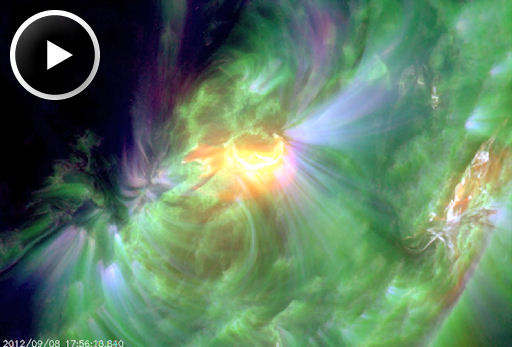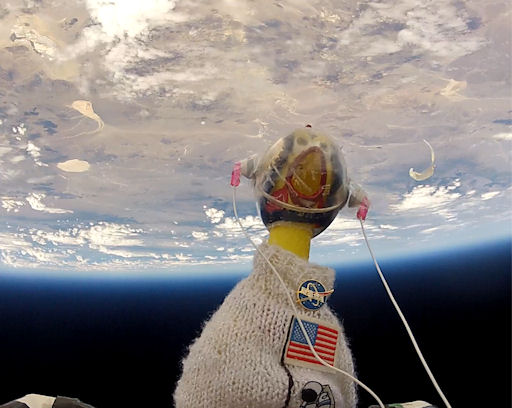MORNING SKY SHOW: On Wednesday morning, Sept. 12th, the 15% crescent Moon will pass just a few degrees from brilliant Venus. Look east at daybreak. It's a lovely way to begin the day. [sky map]
ENTANGLED ERUPTION: Interrupting days of quiet, sunspot AR1564 erupted on Saturday, Sept. 8th, producing an M1-class solar flare. NASA's Solar Dynamics Obervatory (SDO) recorded the extreme ultraviolet flash:
The movie shows more than just a single flare. This eruption was "entangled." A magnetic tendril guided a wave of hot plasma all the way from the blast site to another active region (AR1562) on the western limb ~250,000 km away.
Since SDO was launched in 2010, the observatory has recorded hundreds of entangled eruptions. Sometimes they spread like a chain reaction to involve nearly the entire sun. A good example is the global eruption of August 2010. The moral to this story: One little flare can go a long way.
Realtime Space Weather Photo Gallery
SUBORBITAL CHICKEN: On Wednesday Sept. 5th a group of California high school students celebrated the 35th anniversary of the launch of Voyager 1 in an unusual way: They launched a rubber chicken. The popular NASA mascot Camilla traveled to the top of our planet's atmosphere on board a suborbital helium balloon. Here is a snapshot from an altitude of approximately 120,000 feet:
Camilla is wearing headphones. Why? Because she's listening to the Golden iPod, the modern-day successor to the Golden Records bolted to the side of the Voyager probes. The students are updating the Golden Records with 21st-century content that the students would like to send into the cosmos. This was just a test flight; in 2013, they hope to launch the Golden iPod into Earth orbit onboard a CubeSat they are building.
At the apex of the Sept. 5th suborbital flight, the helium balloon popped as planned and Camilla parachuted back to Earth. The students, who call their group "Earth to Sky," recovered Camilla and the Golden iPod from a remote landing site in the Nevada wilderness on Sept. 6th. Now they are all enjoying music that has been to the doorstep of space itself.
More information about the flight and the recovery expedition may be found at Earth to Sky's Facebook page. Students who wish to participate in the Golden iPod project can submit their ideas for the iPod's playlist at goldenipod.org.

![]()
Solar wind
speed: 355.0 km/sec
density: 0.6 protons/cm3
explanation | more data
Updated: Today at 1536 UT
![]()
X-ray Solar Flares
6-hr max: C3 1255 UT Sep10
24-hr: C3 1255 UT Sep10
explanation | more data
Updated: Today at: 1500 UT
![]()
![]()
![]()
Daily Sun: 10 Sep 12
![]()
![]()
Sunspot complex 1654-1658 has a beta-bamma magnetic field that harbors energy for M-class solar flares. Credit: SDO/HMI
![]()
![]()
![]()
Sunspot number: 87
What is the sunspot number?
Updated 10 Sep 2012
Spotless Days
Current Stretch: 0 days
2012 total: 0 days (0%)
2011 total: 2 days (<1%)
2010 total: 51 days (14%)
2009 total: 260 days (71%)
Since 2004: 821 days
Typical Solar Min: 486 days
Update 10 Sep 2012
The Radio Sun
10.7 cm flux: 123 sfu
explanation | more data
Updated 10 Sep 2012
![]()
![]()
![]()
Current Auroral Oval:
![]()
Switch to: Europe, USA, New Zealand, Antarctica
Credit: NOAA/POES
![]()
![]()
![]()
Planetary K-index
Now: Kp= 2 quiet
24-hr max: Kp= 2 quiet
explanation | more data
![]()
Interplanetary Mag. Field
Btotal: 5.3 nT
Bz: 0.1 nT north
explanation | more data
Updated: Today at 1537 UT
![]()
![]()
![]()
Coronal Holes: 10 Sep 12
![]()
![]()
There are no large coronal holes on the Earthside of the sun. Credit: SDO/AIA. ![]()






